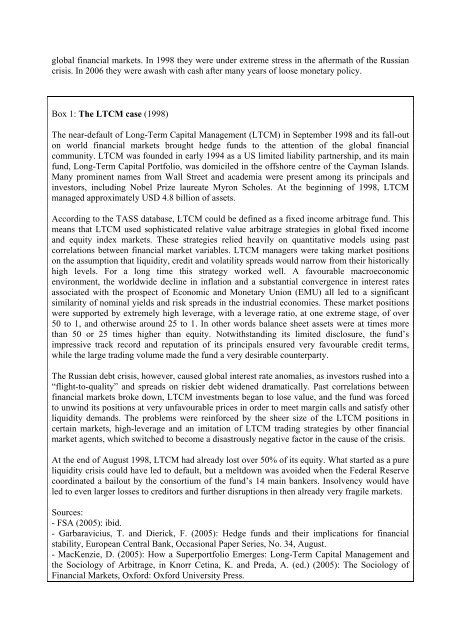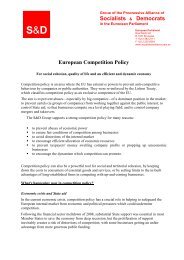Executive summary - Udo Bullmann
Executive summary - Udo Bullmann
Executive summary - Udo Bullmann
- No tags were found...
Create successful ePaper yourself
Turn your PDF publications into a flip-book with our unique Google optimized e-Paper software.
global financial markets. In 1998 they were under extreme stress in the aftermath of the Russiancrisis. In 2006 they were awash with cash after many years of loose monetary policy.Box 1: The LTCM case (1998)The near-default of Long-Term Capital Management (LTCM) in September 1998 and its fall-outon world financial markets brought hedge funds to the attention of the global financialcommunity. LTCM was founded in early 1994 as a US limited liability partnership, and its mainfund, Long-Term Capital Portfolio, was domiciled in the offshore centre of the Cayman Islands.Many prominent names from Wall Street and academia were present among its principals andinvestors, including Nobel Prize laureate Myron Scholes. At the beginning of 1998, LTCMmanaged approximately USD 4.8 billion of assets.According to the TASS database, LTCM could be defined as a fixed income arbitrage fund. Thismeans that LTCM used sophisticated relative value arbitrage strategies in global fixed incomeand equity index markets. These strategies relied heavily on quantitative models using pastcorrelations between financial market variables. LTCM managers were taking market positionson the assumption that liquidity, credit and volatility spreads would narrow from their historicallyhigh levels. For a long time this strategy worked well. A favourable macroeconomicenvironment, the worldwide decline in inflation and a substantial convergence in interest ratesassociated with the prospect of Economic and Monetary Union (EMU) all led to a significantsimilarity of nominal yields and risk spreads in the industrial economies. These market positionswere supported by extremely high leverage, with a leverage ratio, at one extreme stage, of over50 to 1, and otherwise around 25 to 1. In other words balance sheet assets were at times morethan 50 or 25 times higher than equity. Notwithstanding its limited disclosure, the fund’simpressive track record and reputation of its principals ensured very favourable credit terms,while the large trading volume made the fund a very desirable counterparty.The Russian debt crisis, however, caused global interest rate anomalies, as investors rushed into a“flight-to-quality” and spreads on riskier debt widened dramatically. Past correlations betweenfinancial markets broke down, LTCM investments began to lose value, and the fund was forcedto unwind its positions at very unfavourable prices in order to meet margin calls and satisfy otherliquidity demands. The problems were reinforced by the sheer size of the LTCM positions incertain markets, high-leverage and an imitation of LTCM trading strategies by other financialmarket agents, which switched to become a disastrously negative factor in the cause of the crisis.At the end of August 1998, LTCM had already lost over 50% of its equity. What started as a pureliquidity crisis could have led to default, but a meltdown was avoided when the Federal Reservecoordinated a bailout by the consortium of the fund’s 14 main bankers. Insolvency would haveled to even larger losses to creditors and further disruptions in then already very fragile markets.Sources:- FSA (2005): ibid.- Garbaravicius, T. and Dierick, F. (2005): Hedge funds and their implications for financialstability, European Central Bank, Occasional Paper Series, No. 34, August.- MacKenzie, D. (2005): How a Superportfolio Emerges: Long-Term Capital Management andthe Sociology of Arbitrage, in Knorr Cetina, K. and Preda, A. (ed.) (2005): The Sociology ofFinancial Markets, Oxford: Oxford University Press.





